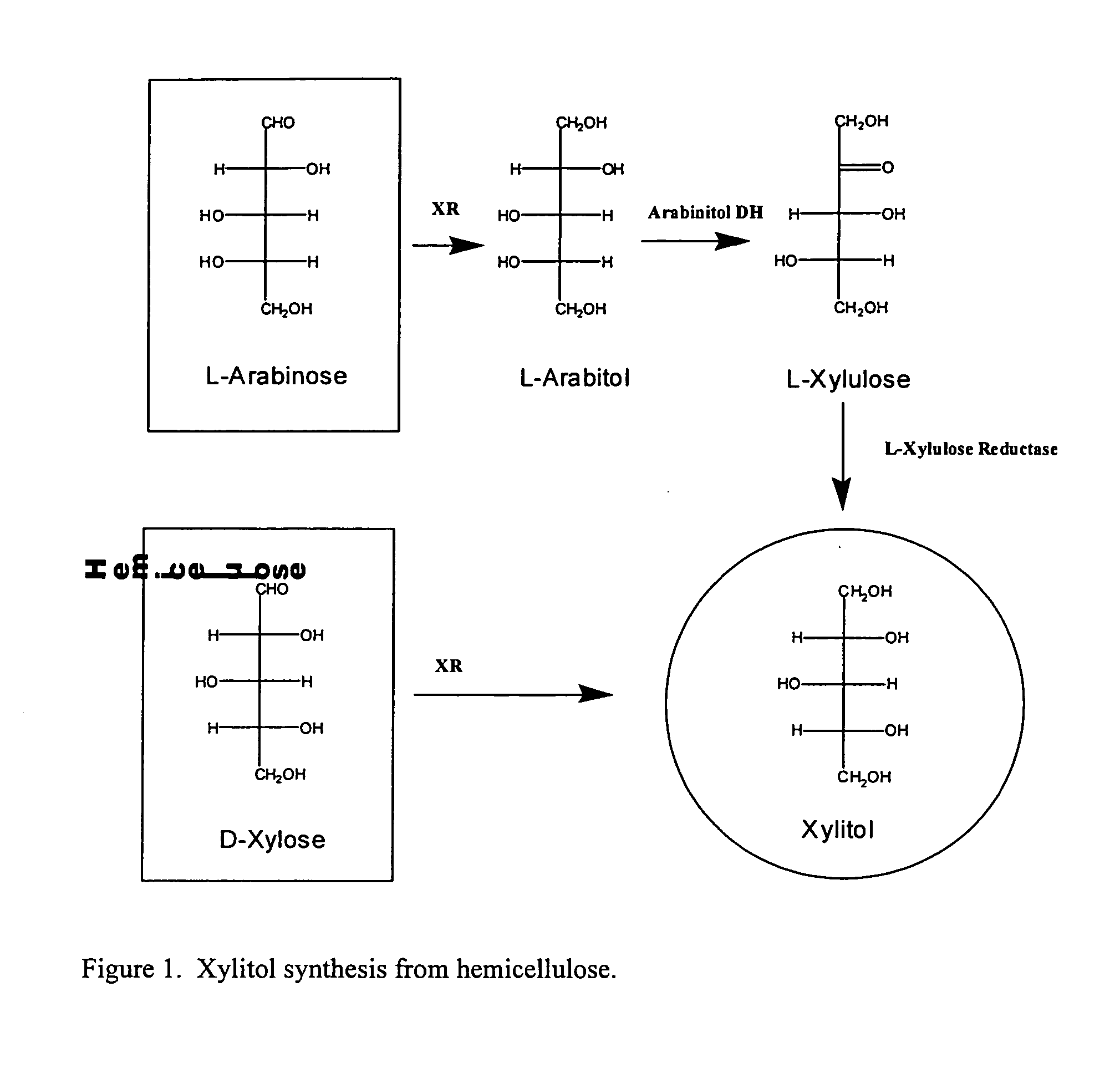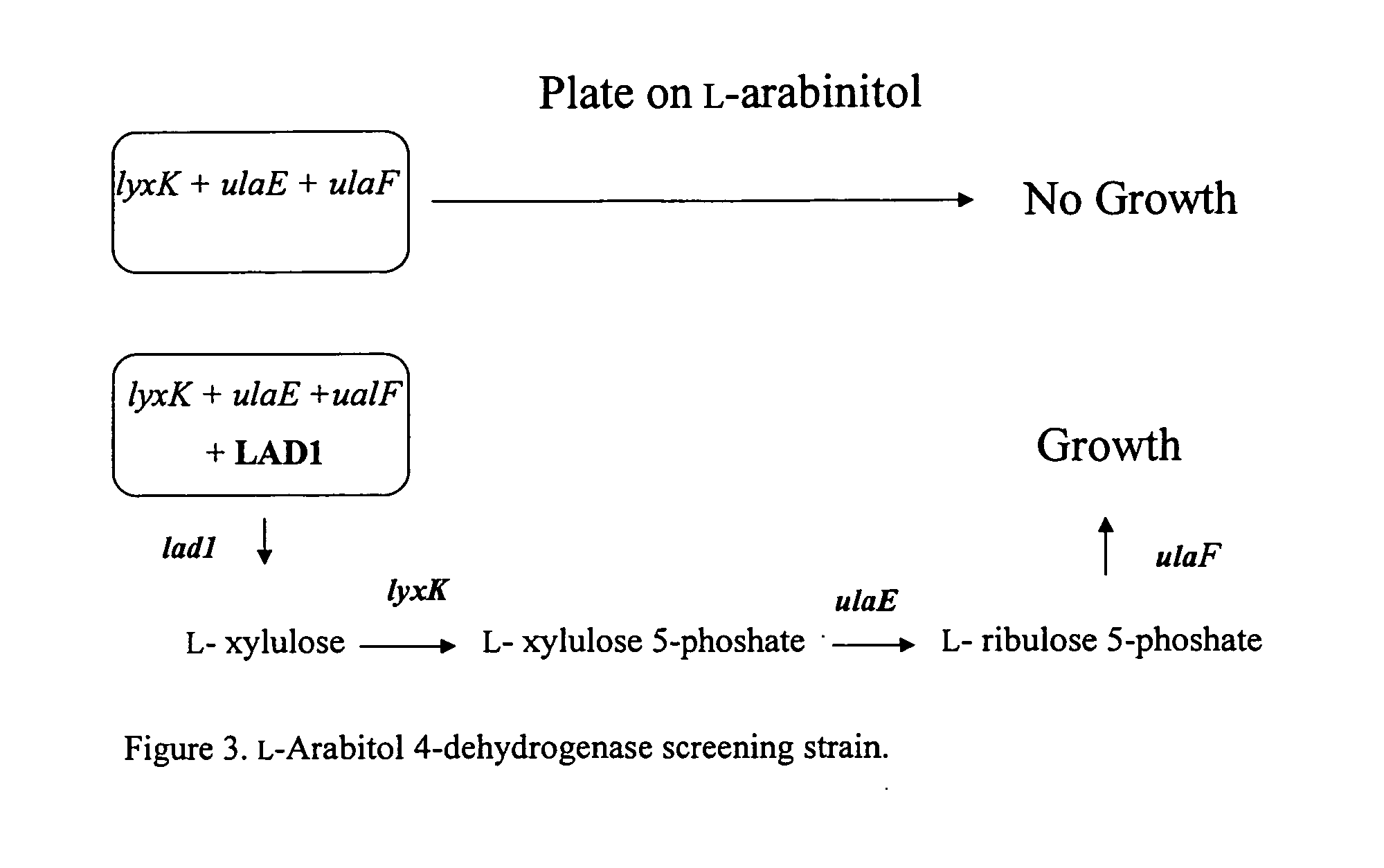Methods for production of xylitol in microorganisms
a technology of xylitol and microorganisms, which is applied in the field of methods for producing xylitol in microorganisms, can solve the problems of unsuitable xylitol production strains, the volumetric productivity of developed strains does not reach the level necessary for a commercially viable process, and the development of commercially feasible microbial production processes remains elusive, so as to achieve the effect of improving xylitol synthesis
- Summary
- Abstract
- Description
- Claims
- Application Information
AI Technical Summary
Benefits of technology
Problems solved by technology
Method used
Image
Examples
example 1
Cloning and Preliminary Analysis of the Pichia stipitis Xylose Reductase Gene Expressed in E. coli
[0125] A Pichia stipitis XR was cloned using primers designed from the published sequence (GenBank Acc. # X59465) by reverse transcriptase-PCR (RT-PCR). P. stipitis was grown overnight on YM media containing 1% D-xylose (w / v). Total RNA was isolated using the NucleoSpin RNA II kit (Promega). The gene was amplified using specific primers (SEQ ID NO:1 and SEQ ID NO:2, Table 2) and the Access RT-PCR system (BD Biosciences, USA) with an Eppendorf Mastercycler PCR machine, using standard amplification parameters. The RT-PCR reaction yielded a single band by gel electrophoresis. The gene was restricted with KpnI and BamHI using standard conditions then ligated using a rapid DNA ligation kit (Takara v.2, Takara Miros Bio, USA) into the cloning and expression plasmid pTTQ18, restricted with the same enzymes to yield pZUC5 (FIG. 7). DNA sequencing (AGCT, Northbrook, Ill.) showed complete identi...
example 2
Cloning of the yafB Aldose Reductase from E. coli K12
[0129] The Escherichia coli aldose reductase (putative XR) gene was cloned using the annotated sequence of yafB (GenBank, Acc. # AE000129). The gene was cloned directly from the genomic DNA of E. coli K12 strain ER1793. The genomic DNA was isolated using a modified procedure of the Qiagen miniprep (Qiagen Inc., USA) kit using a 2 mL culture of ER1793 grown overnight in Lauria-Bertani (Miller) media (LB). The procedure differs from the standard procedure in the addition of a 5 min vortexing step of the DNA sample after addition of buffer 2. The modified procedure gave a large distribution of DNA fragment sizes as seen by agarose gel electrophoresis. The gene was amplified by PCR using specific primers (SEQ ID NO:3 and SEQ ID NO:4, Table 2) in an Eppendorf Mastercyler PCR machine from genomic DNA using a FailSafe PCR cloning kit (Epicentre, USA). This reaction yielded a single band when visualized by agarose gel electrophoresis. Th...
example 3
Cloning and Preliminary Analysis of the Candida tenuis Xylose Reductase Gene
[0130] The Candida tenuis XR was cloned using primers designed from the published sequence (GenBank Acc. # AF074484) by RT-PCR. C. tenuis was grown overnight on YM media containing 1% D-xylose (w / v). The total RNA was isolated using the NucleoSpin RNA II kit (Promega, USA). The gene was amplified using specific primers (SEQ ID NO:5 and SEQ ID NO:6, Table 2) and the Access RT-PCR system (BD Biosciences, USA) with an Eppendorf Mastercycler PCR machine using standard amplification parameters. The RT-PCR reaction yielded a single band by gel electrophoresis. The amplified fragment was restricted with EcoRI and BamHI using standard conditions then ligated using a rapid ligation kit (Takara v.2, Takara Miros Bio, USA) into the cloning and expression plasmid pTTQ18, restricted with the same enzymes to yield pZUC30 (FIG. 9). DNA sequencing (AGCT, Northbrook, Ill.) showed complete identity to the published sequence....
PUM
| Property | Measurement | Unit |
|---|---|---|
| Temperature | aaaaa | aaaaa |
| Temperature | aaaaa | aaaaa |
| Fraction | aaaaa | aaaaa |
Abstract
Description
Claims
Application Information
 Login to View More
Login to View More - R&D
- Intellectual Property
- Life Sciences
- Materials
- Tech Scout
- Unparalleled Data Quality
- Higher Quality Content
- 60% Fewer Hallucinations
Browse by: Latest US Patents, China's latest patents, Technical Efficacy Thesaurus, Application Domain, Technology Topic, Popular Technical Reports.
© 2025 PatSnap. All rights reserved.Legal|Privacy policy|Modern Slavery Act Transparency Statement|Sitemap|About US| Contact US: help@patsnap.com



